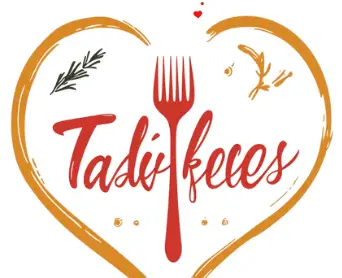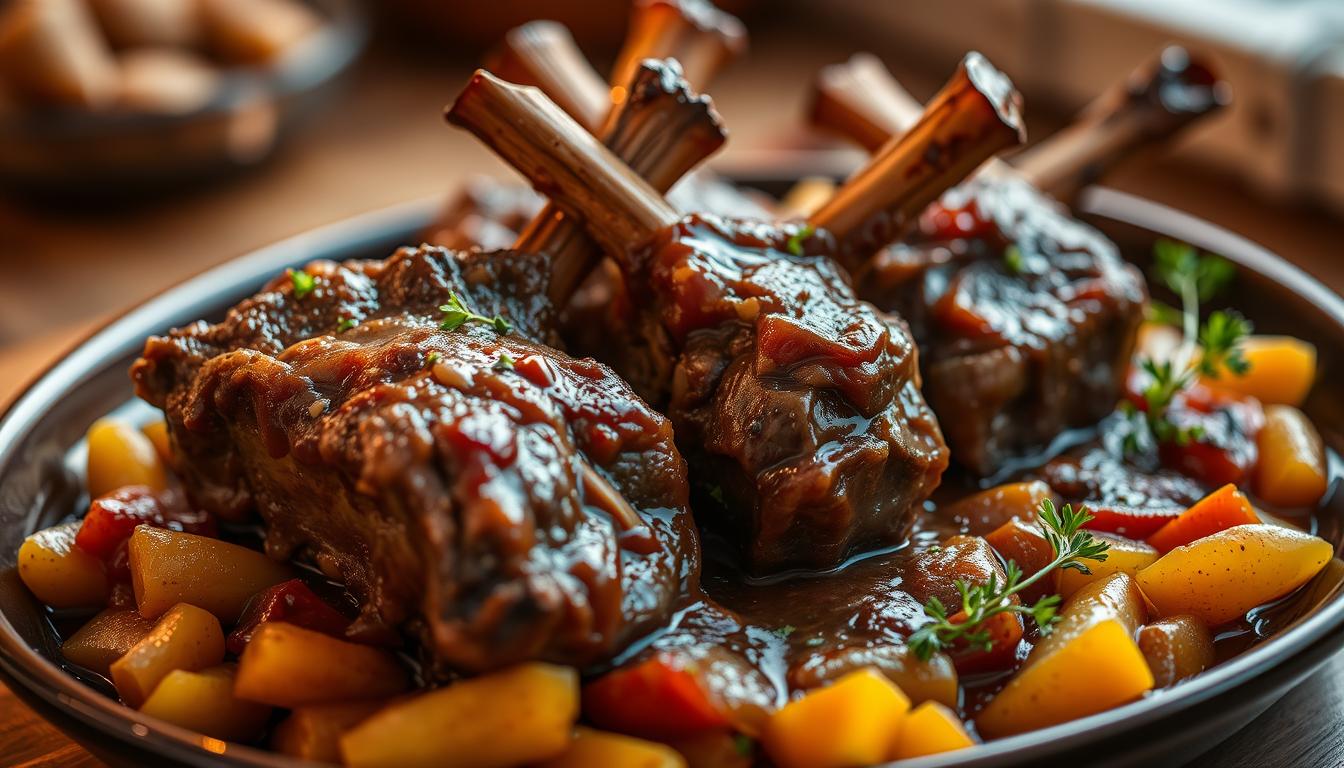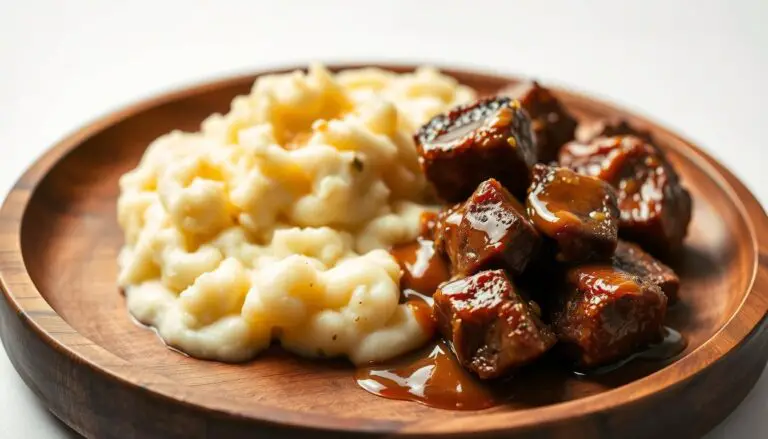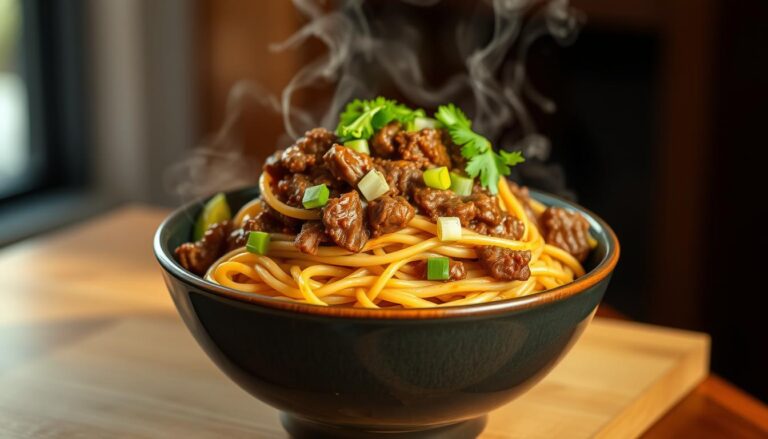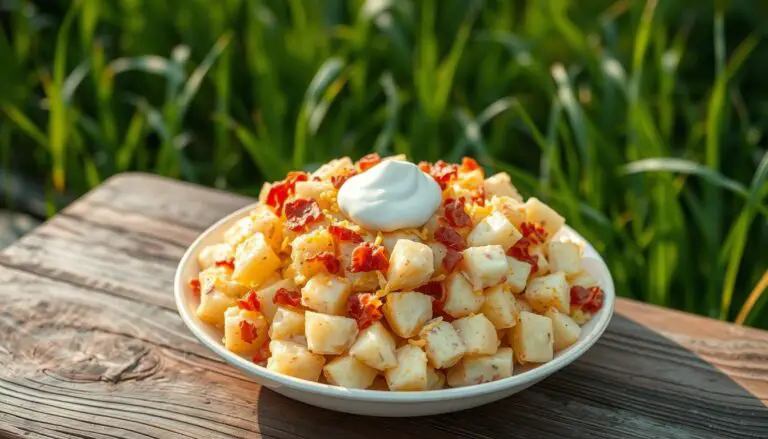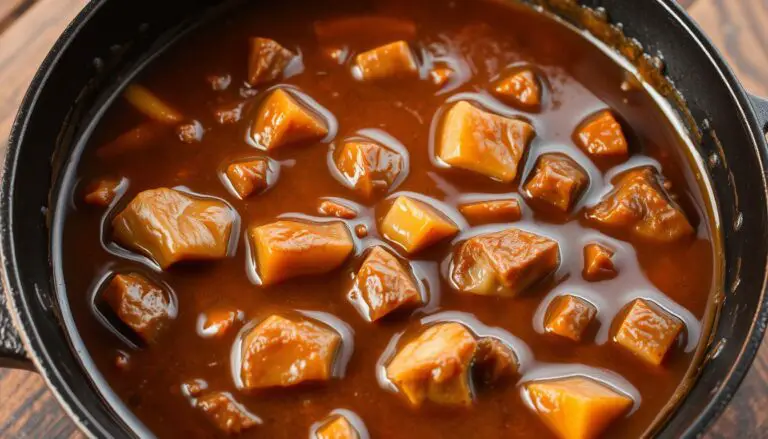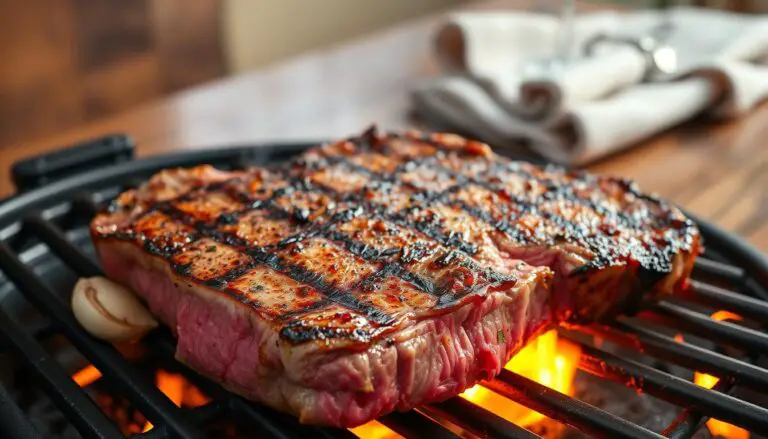There’s something special about a hearty, Slow Cooked Lamb Shanks that warms the soul. For me, slow-cooked lamb shanks are one of those dishes that never fails to impress. Not only are they forgiving and easy to cook, but they also result in a rich, deeply flavored meal that’s perfect for any occasion.
I still remember the first time I made lamb shanks; the tender meat just fell off the bone, and the sauce was rich and savory. It’s a simple yet impressive recipe that’s sure to become a favorite. In this article, I’ll share with you why lamb shanks have become a staple in my kitchen and provide you with a straightforward recipe to try at home.
Key Takeaways
- Easy to prepare lamb shanks recipe for a comforting meal
- Benefits of using lamb shanks for a tender and flavorful dish
- Tips for achieving the perfect fall-off-the-bone tenderness
- Versatility of lamb shanks in different cooking methods
- Simple ingredients for a rich and savory sauce
What Are Lamb Shanks and Why They’re Perfect for Slow Cooking
Lamb shanks, characterized by their tough texture, are actually a culinary gem when prepared correctly. Essentially, lamb shanks are cuts from the lower leg of lambs, known for being both economical and flavorful.
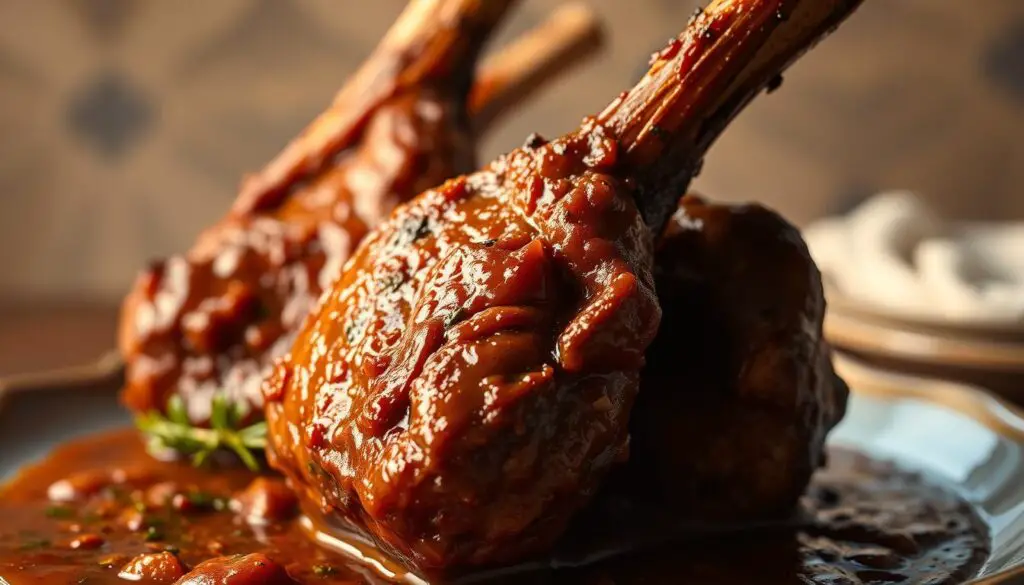
Understanding the Cut
The lamb shank is a tough cut of meat surrounding a thick bone. This characteristic makes it ideal for slow cooking, as the process breaks down the tough muscle tissue, resulting in tender, fall-off-the-bone meat. The unique anatomy of lamb shanks, with the bone at the center, contributes to the richness of the dish, as the marrow melts into the sauce during cooking.
The Benefits of Cooking Lamb Shanks Low and Slow
Cooking lamb shanks low and slow transforms them into a tender, flavorful dish. The slow cooking process breaks down the collagen-rich meat, creating an incredibly tender texture. Additionally, the bone marrow adds depth to the sauce, making it rich and savory. The benefits of slow cooking lamb shanks include:
- Tenderization of tough meat
- Rich, flavorful sauce enhanced by bone marrow
- Economical, as lamb shanks are generally less expensive than other cuts
In summary, lamb shanks are a versatile and flavorful cut of lamb that becomes tender and delicious when slow-cooked, making them perfect for a variety of culinary applications.
The Secret to Flavorful Slow Cooked Lamb Shanks
To unlock the full potential of lamb shanks, it’s crucial to understand the importance of browning and sauce creation. The process of slow cooking lamb shanks is not just about throwing the ingredients together; it’s about creating a rich, deep flavor profile that elevates the dish.
The Importance of Browning
Browning the lamb shanks is a critical step that creates the Maillard reaction, a chemical reaction that forms the foundation of flavor for the entire dish. To achieve the best possible sear, use a moderate amount of oil and ensure your pan is at the right temperature. Patience during this process is key, as it pays off enormously in the final flavor profile.
- Use the right amount of oil to prevent the lamb from sticking to the pan.
- Ensure the pan is hot before adding the lamb shanks.
- Browning on all sides is crucial for a deep flavor base.
Building a Rich Flavor Base
A rich red wine sauce is a classic braising liquid for lamb shanks, complementing the strong flavor of the lamb. The acidity in the red wine helps tenderize the meat, while its complex flavors enhance the overall taste. Adding garlic and other aromatics during the slow cooking process infuses deep into the meat, creating a flavorful dish.
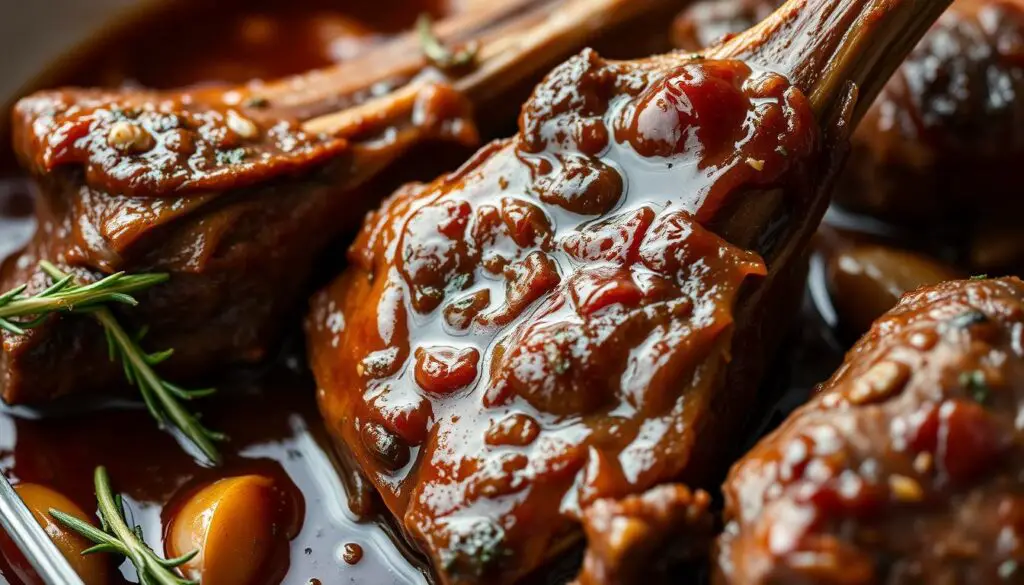
Cooking the lamb shanks in the oven provides a consistent heat that transforms both the meat and the sauce, creating a silky and glossy sauce. As the braising liquid reduces and intensifies during cooking, it results in a restaurant-quality sauce without needing additional reduction steps.
Essential Ingredients for Perfect Lamb Shanks
To achieve tender and flavorful lamb shanks, it’s crucial to start with the right ingredients. The quality and combination of these components will significantly impact the final dish.
The Meat: Selecting Quality Lamb Shanks
When it comes to lamb shanks, selecting the right cut is vital. I recommend choosing lamb shanks that are meaty and have a good balance of fat and lean meat. Typically, you’ll need 1-2 lamb shanks per person, depending on their size and appetite.
The Aromatics and Vegetables
The “holy trinity” of slow cooking – onions, carrots, and celery – forms the foundation of flavor for lamb shanks. While it’s possible to omit the carrots and celery, including them adds depth to the sauce. These aromatics break down during cooking, enriching the overall flavor profile.
The Braising Liquid: Red Wine vs. Broth
Red wine is a popular choice for braising lamb shanks, as it creates a rich, full-bodied sauce. Opt for a full-bodied red wine like Cabernet Sauvignon or Merlot. If you prefer not to use wine, a mixture of beef broth, water, and Worcestershire Sauce can be a suitable substitute. The key is to use a liquid that will enhance the flavor of the lamb without overpowering it.
Herbs like thyme and bay leaves also play a crucial role in adding layers of flavor to the dish. Proper seasoning with salt and pepper is essential, and the timing of when you add these seasonings can impact the final result.
My Slow Cooked Lamb Shanks Recipe
My slow-cooked lamb shanks recipe is a game-changer for anyone looking for a hearty, comforting meal. This dish is perfect for special occasions or a cozy night in, and I’m excited to share it with you.
Ingredients List
To make this delicious lamb shanks dish, you’ll need the following ingredients:
- 4 lamb shanks (around 13 oz / 400g each)
- 1 tsp EACH cooking/kosher salt and pepper
- 2-3 tbsp olive oil (separated)
- 1 onion (finely diced)
- 3 garlic cloves (minced)
- 1 cup carrot (peeled, finely diced)
- 1 cup celery (finely diced)
- 2 1/2 cups red wine (full-bodied)
- 800g / 28oz can crushed tomatoes
- 2 tbsp tomato paste
- 2 cups chicken stock (low sodium)
- 5 sprigs of thyme (preferably tied together)
- 2 dried bay leaves
Using high-quality lamb shanks and fresh vegetables will make a significant difference in the flavor of your dish.
Preparation Steps
Before cooking, it’s essential to prepare your lamb shanks properly. Start by drying them with paper towels and seasoning with salt and pepper. Then, heat 1-2 tbsp of olive oil in a large Dutch oven over medium-high heat. Sear the lamb shanks until they’re browned on all sides, then set them aside. Reduce the heat to medium, add another tbsp of olive oil if necessary, and sauté the diced onion, minced garlic, carrots, and celery until they’re softened.
Cooking Process
To cook the lamb shanks, preheat your oven to 300°F (150°C). Deglaze the pan with red wine, scraping up any browned bits from the bottom. Add the crushed tomatoes, tomato paste, chicken stock, thyme, and bay leaves. Return the lamb shanks to the pot, cover, and transfer to the preheated oven. Cook for about 2 1/2 hours, or until the meat is tender and falls off the bone. Remove the lid for the last 30 minutes to allow the sauce to thicken.
Once cooked, let the lamb shanks rest before serving. You can strain the sauce for a more refined presentation or leave it as is for a heartier dish. Serve hot and enjoy!
Alternative Cooking Methods
While my lamb shank recipe provides a foundation, the cooking method can be adapted to suit various preferences and time constraints. This flexibility is particularly useful when you’re deciding how to prepare your meal.
Slow Cooker Method
The slow cooker method is ideal for busy days, allowing you to cook lamb shanks while you’re away. To use this method, follow the recipe up to step 7, then transfer the lamb shanks and sauce to the slow cooker. Cook on low for 8 hours. After cooking, remove the shanks and reduce the sauce on the stovetop to achieve your desired consistency.
Pressure Cooker/Instant Pot Method
For those short on time, a pressure cooker or Instant Pot can dramatically reduce cooking time. This method yields tender lamb shanks in just 40 minutes under pressure. It’s a great option when you need a quick, flavorful meal.
Traditional Oven Method
Cooking lamb shanks in a traditional oven is another viable option. This method requires more monitoring to ensure the liquid doesn’t evaporate too quickly. However, it provides a rich, flavorful result that’s hard to beat.
Each cooking method produces slightly different results in terms of texture and flavor. By understanding these differences, you can choose the best approach for your specific needs, whether you’re cooking for a special occasion or preparing a meal in advance.
- Slow Cooker: Ideal for busy days, 8 hours on low.
- Pressure Cooker/Instant Pot: Quick, 40 minutes under pressure.
- Traditional Oven: Rich flavor, requires more monitoring.
Troubleshooting and Pro Tips
With a few pro tips and some troubleshooting knowledge, you can achieve tender, flavorful lamb shanks every time. Cooking lamb shanks can sometimes present challenges, but being aware of common issues and their solutions can make all the difference.
Common Issues and How to Fix Them
If your lamb shanks aren’t tender after the recommended cooking time, don’t worry. Simply add more liquid and continue cooking until they reach the perfect fall-off-the-bone stage. Another common issue is a sauce that’s too acidic or sour, often due to poor quality canned tomatoes. To fix this, add a touch of honey or sugar and simmer for a few minutes.
Properly sautéing your vegetables before adding the liquid is also crucial. Cooking them for at least 5 minutes sweetens them, enhancing the overall flavor of your dish.
- Check your canned tomatoes for quality.
- Ensure you don’t rush the vegetable sautéing step.
- Add a touch of sweetness to balance acidity.
Make-Ahead and Storage Tips
Lamb shanks are an excellent choice for meal prep as they reheat beautifully and their flavors continue to develop over time. You can make them up to three days ahead of time and store them in the refrigerator. When reheating, use a gentle heat to prevent the meat from drying out.
For longer storage, you can freeze lamb shanks for up to 3 months. To reheat, thaw overnight in the refrigerator and then reheat using your preferred method – microwave, oven, or stovetop.
Conclusion
By mastering the technique of slow-cooking lamb shanks, you’ll add a versatile and impressive dish to your culinary arsenal. This recipe’s forgiving nature and rich red wine sauce make it perfect for both special occasions and everyday meals.
The key to success lies in proper browning, building a flavorful sauce base, and allowing sufficient cooking time. Whether you use a slow cooker, pressure cooker, or traditional oven, the result is consistently delicious. I encourage you to experiment with different serving suggestions, such as mashed potatoes or crusty bread, to soak up the delicious sauce.
With minimal active preparation required, slow-cooked lamb shanks are ideal for low-effort entertaining. This classic dish opens the door to exploring other slow-cooked meat recipes using similar techniques, making it a valuable addition to your cooking repertoire.
